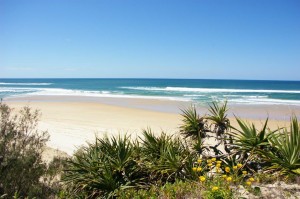About Fraser Island

Fraser Island, the world’s largest sand island. It is a World Heritage site where magnificent tall rainforests grow out of sand dunes and its beautiful perched freshwater lakes make it one of the wonders of Australia. With over a hundred kilometres of beautiful beach it is a fisherman’s paradise.
You need a 4WD vehicle to explore the Island and access is by vehicular barge from either Inskip Point or River Heads at Hervey Bay.
Some Fraser Facts – Did you Know?
Named after Captain and Eliza Fraser: Europeans named the place “Fraser Island” in memory of Captain Fraser and his wife Eliza. In 1836 his ship the Stirling Castle was wrecked off the north Queensland coast. Survivors, including the Captains wife Eliza, drifted ashore on Fraser Island in a lifeboat. They lived with Butchulla people for about six weeks before being rescued. But these were not the first Europeans to see the island. Matthew Flinders set foot here and met the Butchulla in 1799 and 1802. Captain Cook named Indian Head back in 1770, but did not land. There is some evidence of much earlier visits by Portuguese and Dutch explorers.
Largest Sand Island in the World: Fraser Island is the largest sand island in the world with a land area totalling 1,840 km2. These dunes are 500,000 years old and the island is 800,000 years old. The highest dune is 244 metres above sea level. Fraser Island is also Australia’s largest island (excluding Tasmania), stretching some 123 kilometres from north to south and 22 kilometres wide at one point.
Rare Rainforests: This is the only place in the world where tall rainforests can be found growing atop sand dunes above 200 metres. Logging commenced in 1863 and ceased in 1991 when the Great Sandy National Park was created.
Perched (Dune) lakes: Half of all the perched lakes in existence anywhere on Earth are to be found on this one island. Fraser Island boasts forty. A perched lake is formed when organic matter such, as leaves, builds up and eventually solidifies in dune depressions created by the wind. These depressions then fill with water. Boomanjin is the World’s largest perched lake. There are over 100 lakes on Fraser Island. In Australia only Tasmania has a higher concentration. It is estimated that Fraser Island contains up to 20 million mega litres of natural water storage, some of it up to 100 metres below sea level.
Whales: An adult humpback whale can be up to 14.6 metres long and weigh up to 36,000 kilograms. It is estimated that up to 2,000 whales pass by this way each year.
Dingo’s: Fraser Island dingo’s are the most pure strain found in eastern Australia. Elsewhere dingo’s have inter bred with domestic dogs. But the separation of Fraser Island from the mainland and the absence of domestic dogs has enabled dingo’s here to remain pure.
Abundant Bird Life: Birds are the most abundant animals on the island, with more than three hundred and fifty known species. This is a particularly important site for migratory wading birds on their annual journey of endurance between southern Australia and their breeding grounds in Siberia. The endangered ground parrot is also found here in the wallum heathland. Other species include Blackbreasted Button Quails, Assure Kingfishers, Red Backed Fairy Wrens, Beach Stone Curlews, Norton Mallard, Kelp Gull, The popular Fraser Island Bird Week is held in May each year.
World Heritage Listing: Fraser Island was deservedly placed on the World Heritage List in 1991. It was the first place in Australia have this honour. World heritage listing is reserved for places of great natural and cultural significance.